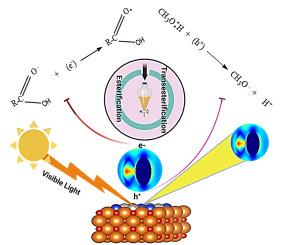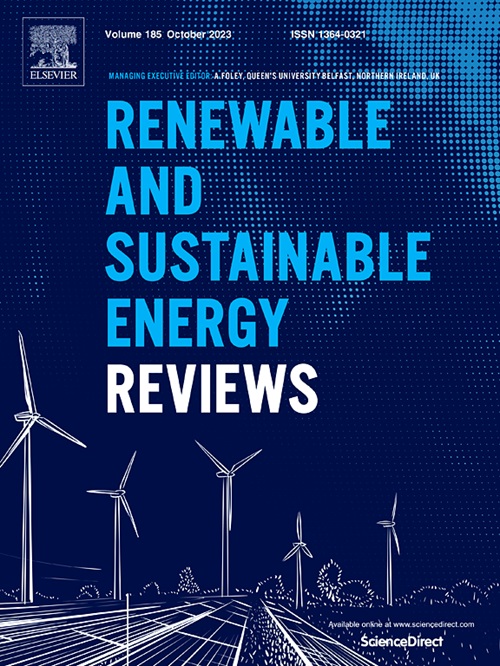Harnessing visible light for sustainable biodiesel production with Ni/Si/MgO photocatalyst
IF 16.3
1区 工程技术
Q1 ENERGY & FUELS
引用次数: 0
Abstract
Sustainable energy sources frequently demonstrate greater reliability and resilience in comparison to conventional energy sources. Biodiesel, with its markedly reduced carbon footprint when compared to petroleum-based diesel fuel, owes this advantage to its production from renewable resources. Heterojunction photocatalysts have gained significant interest due to their immense promise in tackling environmental challenges. In this study, a highly efficient photocatalyst, Ni/Si/MgO, for biodiesel production under visible light irradiation was synthesized using a solid-phase reaction method with silica as the silicon source, along with Ni and MgO. The surface functionality of Ni/Si/MgO was crucial for achieving high efficiency of photocatalytic systems, as evident from XPS. The transesterification reaction on the Ni/Si/MgO photocatalyst proceeds by the formation of SiH and SiOH bonds over the catalyst. The photocatalytic activities of Ni/Si/MgO photocatalysts were higher than those of the Si/MgO nanoparticle when exposed to light. Achieving an optimal yield of 98 %, the biodiesel production was carried out under the following reaction conditions: A catalyst dosage of 2 % by weight was utilized, along with a methanol-to-oil molar ratio of 12:1, and the entire procedure was executed within a duration of 3.5 h. Plasmonic near-fields are speculated to be responsible for the increased transesterification activity along the Ni/Si/MgO interface. In order to carry out the transesterification reaction, electron-hole pairs are generated along the Ni/Si/MgO interface, where plasmonic near-fields are highly concentrated. This study contributes a significant perspective on mechanisms governing the process of efficient plasmonic photocatalysis responsive to visible light. These findings hold the potential to offer valuable guidance in the formulation and design of next-generation, high-performance photocatalysts.

利用可见光与 Ni/Si/MgO 光催化剂实现生物柴油的可持续生产
与传统能源相比,可持续能源往往具有更高的可靠性和复原力。与石油柴油相比,生物柴油的碳足迹明显减少,这一优势得益于它是用可再生资源生产的。异质结光催化剂在应对环境挑战方面大有可为,因而备受关注。本研究采用固相反应法,以二氧化硅为硅源,与镍和氧化镁一起合成了一种用于在可见光照射下生产生物柴油的高效光催化剂--Ni/Si/MgO。从 XPS 可以看出,Ni/Si/MgO 的表面功能对于实现光催化系统的高效率至关重要。Ni/Si/MgO 光催化剂上的酯交换反应是通过催化剂上 SiH 和 SiOH 键的形成进行的。在光照下,Ni/Si/MgO 光催化剂的光催化活性高于 Si/MgO 纳米粒子。在以下反应条件下,生物柴油的最佳产率达到 98%:据推测,Ni/Si/MgO 界面的等离子体近场是提高酯交换活性的原因。为了进行酯交换反应,电子-空穴对沿着镍/硅/氧化镁界面产生,而等离子体近场高度集中于此。这项研究从一个重要的角度揭示了对可见光做出反应的高效质子光催化过程的机制。这些发现有望为下一代高性能光催化剂的配方和设计提供有价值的指导。
本文章由计算机程序翻译,如有差异,请以英文原文为准。
求助全文
约1分钟内获得全文
求助全文
来源期刊

Renewable and Sustainable Energy Reviews
工程技术-能源与燃料
CiteScore
31.20
自引率
5.70%
发文量
1055
审稿时长
62 days
期刊介绍:
The mission of Renewable and Sustainable Energy Reviews is to disseminate the most compelling and pertinent critical insights in renewable and sustainable energy, fostering collaboration among the research community, private sector, and policy and decision makers. The journal aims to exchange challenges, solutions, innovative concepts, and technologies, contributing to sustainable development, the transition to a low-carbon future, and the attainment of emissions targets outlined by the United Nations Framework Convention on Climate Change.
Renewable and Sustainable Energy Reviews publishes a diverse range of content, including review papers, original research, case studies, and analyses of new technologies, all featuring a substantial review component such as critique, comparison, or analysis. Introducing a distinctive paper type, Expert Insights, the journal presents commissioned mini-reviews authored by field leaders, addressing topics of significant interest. Case studies undergo consideration only if they showcase the work's applicability to other regions or contribute valuable insights to the broader field of renewable and sustainable energy. Notably, a bibliographic or literature review lacking critical analysis is deemed unsuitable for publication.
 求助内容:
求助内容: 应助结果提醒方式:
应助结果提醒方式:


